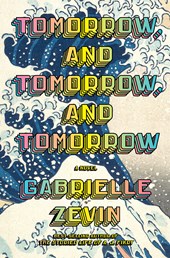Tomorrow, and Tomorrow, and Tomorrow
July 07, 2022
Sam, Sadie, and Marx's stories may begin in similar places, but it becomes evident how a significant part of their lives is determined not by their goals but by their mindsets. They rely on virtual lives over physical, at least until the two become more intertwined.
Tomorrow, and Tomorrow, and Tomorrow by Gabrielle Zevin, Knopf
If someone was to convince me of the allegorical and enlightening abilities of video games, of course it should be Gabrielle Zevin. Ever since I was in elementary school, I've been an admirer of Zevin’s coming-of-age stories. Her young adult novel Elsewhere was the first to make me cry; I remember staring at the final page for several minutes, confused as to how a fictional story set in a fictional place could make me feel such real sorrow.
Across Zevin’s repertoire, she is especially good at building relatable, realistic, and surprising character arcs. In Tomorrow, Tomorrow, and Tomorrow, Zevin traces three decades of the lives of video game designers Sam, Sadie, and Marx during the late ‘90s and early 2000s from their first encounters as children and young adults through the successes, failures, and lessons learned in making their first, second, and third games, founding a company, and all the complications and permanent uncertainties of being human in-between.
The style of this nearly 400-page narrative reflects Sam’s opinion on video game spoilers:
He didn’t believe it was possible to spoil a game. The point was not what happened, but the process of getting to what happened.
Throughout the book, Zevin works in glimpses at the future, often in the form of interviews with magazines or websites, presaging their eventual popularity and success.
While the main cast of Tomorrow, and Tomorrow, and Tomorrow is small, even characters that you encounter briefly throughout the book are presented in ways that stress their impact on the main characters’ pasts, presents, and futures. Relationships and their changeability or instability are central to the novel. Zevin illustrates in several instances how making connections with other people can help us see ourselves more clearly.
For example, when a woman jumps off a building in a suicide attempt, she lands on the sidewalk in front of a nine-year-old Sam Mazer and his mother Anna Lee. Anna sends Sam to a nearby bodega to ask someone to call 911, and in the meantime, Anna makes small talk with the woman who jumped from the building who was also Asian and named Anna Lee.
She stood over the other Anna Lee’s body and began to feel giddily, vertiginously untethered from her own body. She felt as if she were seeing herself dead on that sidewalk.
This feeling is reflected later on in the novel by Sadie when we learn how her idea for the game Both Sides comes from a scary feeling of otherworldliness, which she defines by two moments in her life. First, when a formerly close friend of hers died from an eating disorder, she felt “as if she were the one who was supposed to have died, and that somehow she and the friend had switched places.” And the second was the twelve hours that Sam is missing:
For a moment, she felt dangerously untethered from her body and from reality, and she had to sit down to feel the ground beneath her, before she could continue searching for Sam.
In stressful situations, both feel “untethered” and see themselves in other dead women. In Anna’s case, both her and the other Anna being women of color in America encourages the immediate connection she feels. I was reminded of a short documentary called The Grace Lee Project (2005). Documentarian Grace Lee moves to a larger city where she finds out that not only are there a lot more Grace Lees, but that people overwhelmingly describe these women as “nice,” “quiet,” and “smart.” She investigates these claims, interviewing the other Grace Lees, and quickly proves that it is the expectations Americans have for women with the name Grace Lee that are defining the women. By the end of the documentary, we must ask ourselves if women ever get the chance to define themselves before society does it for us.
Coming to terms with the constraints of reality but also recognizing one’s own power (however limited) to determine reality is one of many themes in Tomorrow, Tomorrow, and Tomorrow. And this theme pushes forward the larger question of whether life is defined more by decision-making or by fate. Where we choose to live and who surrounds us, for example, also helps us define how we assert ourselves in the world. For Sam and Marx, being Jewish Korean and Japanese Korean, respectively, is a determining factor in their lives. Marx was an actor in college who was always typecast as “ligneous strongmen or priggish dukes,” which a friend eventually clarified was because Marx was Asian. “Until Harvard, he had not realized that in America–and not just in its college theaters–there were only so many roles an Asian could play.” Similarly, Sam’s introduction to Koreatown changed his idea of himself in the world.
In Koreatown, no one ever thought Sam was Korean. In Manhattan, no one had ever thought he was white. In Los Angeles, he was the ‘white cousin.’ In New York, he was that ‘little Chinese kid.’ And yet, in K-town, he felt more Korean than he ever had before. Or to put a finer point on it, he felt more aware of the fact that he was a Korean and that that was not necessarily a negative or even a neutral fact about him. The awareness gave him pause: perhaps a funny-looking mixed-race kid could exist at the center of the world, not just on its periphery.
There are so many quotes like this in the book that validated my own experiences, questions, and hopes. Through Sam, Sadie, and Marx, we realize that whatever our life may be, there is always an alternative set of choices to make, of events to fall into place, of people to love, and people to lose. Several times throughout the book, Sam and Sadie express their preference for “the world of infinite restarts” of a video game—where players have control but, as designers, they have even more control. As Sadie reminisces:
Mazer and I were best friends growing up, and we loved playing games together. We were obsessed with the idea of the perfect play. The idea that there was a way to play any game that had the minimal number of errors, the least moral compromises, the quickest pace, the highest number of points. The idea that you could play a game without ever dying or restarting. We’d be playing Super Mario, and if we missed even one gold coin, or got hit by one Koopa, we’d begin again. Yes, we were probably disturbingly obsessive and yes, we had a lot of time on our hands. Anyway, for a long time, I took this idea into the work I did as a designer, and it was absolutely paralyzing.
Sam, Sadie, and Marx's stories may begin in similar places, but it becomes evident how a significant part of their lives is determined not by their goals but by their mindsets. They rely on virtual lives over physical, at least until the two become more intertwined.
For Sam, his disabled foot and the pain that comes with it already impedes his real life enough, so he turns to video games to forget his own body. However, when Sam goes on tour to promote his, Sadie, and Marx’s game Ichigo, he transforms into someone more confident, captivating audiences with the story of his and Sadie’s friendship and eventual business partnership. “He was more handsome in front of a crowd; his limp, less apparent; his voice, warm and authoritative. It was as if all these years Sam had been waiting for an audience.”
For Sadie, virtual worlds are where her creativity can shine, where her mind can be on full display without having to explain herself. Her unique and thought-provoking (and, for some students, anger-inducing) video game Solution attracts the attention of her professor Dov, who becomes her boyfriend. And, to return to the theme of women’s feelings of inadequate control over themselves, Sadie’s introversion is explained when their video game publisher, Opus, sends Sam on tour, and Sadie gets jealous, but only to a small degree, because she isn't comfortable talking about their work to the public:
There were so few prominent female game designers, and there wasn’t exactly a playbook for how a female game designer was supposed to present herself. But the fact is, no one at Opus was pushing Sadie to put herself forward either. The men at Opus wanted Sam to be the face of Ichigo, and so he was. The gaming industry, like many industries, loves its wonder boys.
For Marx, video games are a way for him to enjoy several versions of life, and producing video games becomes a way for him to spend time with people he loves. Just the same as his time as a student actor, “it wasn’t so much being on stage that he loved, but the productions themselves. He loved the intimacy of being in a tight group of people who had come together, miraculously, for a brief period in time, for the purpose of making art.”
The way that Zevin describes it, what Sam, Sadie, and Marx make feels like more than art. They create alternate, more equitable worlds for others to feel at home in. These worlds are where gay marriage is legal, horses can be a precise shade of azure, physical pain doesn't’ exist, death is temporary, and choices feel limitless.
Playing video games basically comes with all the benefits of reading books of fiction. So does that mean reading a book about video games offers double the benefits?
As Marx says to Sam:
It isn’t a sadness, but a joy that we don’t do the same things for the length of our lives.
This idea, that “variety is the spice of life,” is what enamors me about the story. The ending is not typical, nor would I say is it an ending I enjoy. Not that there are many enjoyable endings. What I love about Tomorrow, Tomorrow, and Tomorrow is the process of learning and experiencing life alongside its characters. Just writing about the book inspires me and makes me feel like I lived an impressive amount of lives in the four weeks it took me to read the book.
But there are so many details, big events, and elements that I left out and want to discuss. Please, once you read it, let’s talk about the strawberry motif: Ichigo’s name means strawberry, Marx’s mother presents upholstery with a reproduction of “Strawberry Thief” by William Morris, and Marx imagines flying over a strawberry field. Can we laugh together about Sadie’s imagined monologue in reply to a customs agent who asks about how she got into making video games? And how sympathetic I felt when Sam imagines a whole future for Sadie and Marx involving a wedding by the sea, a dog named Zelda or Rosella, and how miserable he would look beside them. This book defines love in a thousand different shades, and I can only hope it encourages us all to love, fail, and—though we can't click restart—try again too.




